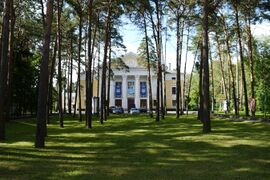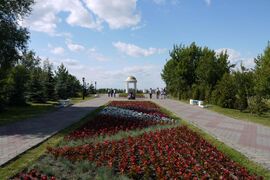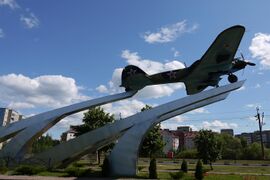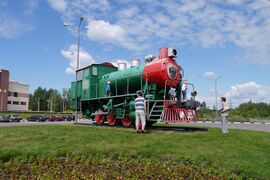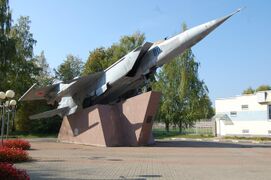Organization:Dubna
Dubna (Russian: Дубна́) is a town in Moscow Oblast, Russia . It has a status of naukograd (i.e. town of science), being home to the Joint Institute for Nuclear Research, an international nuclear physics research center and one of the largest scientific foundations in the country. It is also home to MKB Raduga, a defense aerospace company specializing in design and production of missile systems, as well as to the Russia's largest satellite communications center owned by Russian Satellite Communications Company.[1] The modern town was developed in the middle of the 20th century and town status was granted to it in 1956. Population: 70,663 (2010 Census);[2] 60,951 (2002 Census);[3] 65,805 (1989 Census).[4]
Geography
The town is 120 meters (390 ft) above sea level, situated approximately 125 kilometers (78 mi) north of Moscow, on the Volga River, just downstream from the Ivankovo Reservoir. The reservoir is formed by a hydroelectric dam across the Volga situated within the town borders. The town lies on both banks of the Volga. The western boundary of the town is defined by the Moscow Canal joining the Volga, while the eastern boundary is defined by the Dubna River joining the Volga.[citation needed]
Dubna is the northernmost town of Moscow Oblast.[citation needed]
History
Pre-World War II
Fortress Dubna (Russian: Дубна) belonging to Rostov-Suzdal Principality was built in the area in 1132 by the order of Yuri Dolgoruki and existed until 1216. The fortress was destroyed during the feudal war between the sons of Vsevolod the Big Nest. The village of Gorodishche (Городище) was located on the right bank of the Volga River and was a part of the Kashin Principality. Dubna customs post (Дубненское мыто) was located in the area and was a part of the Principality of Tver.
Before the October Revolution, few villages were in the area: Podberezye was on the left bank of the Volga, and Gorodishche, Alexandrovka, Ivankovo, Yurkino, and Kozlaki (Russian: Козлаки) were on the right bank.
Right after the Revolution one of the first collective farms was organized in Dubna area.
In 1931, the Orgburo of the Communist Party made a decision to build the Volga-Moscow Canal. Genrikh Yagoda, then the leader of the State Political Directorate, was put in charge of construction. The Canal was completed in 1937. Ivankovo Reservoir and Ivankovo hydroelectrical plant were also created as a part of the project. Many villages and the town Korcheva were submerged under water. Dubna is mentioned in Aleksandr Solzhenitsyn's book The Gulag Archipelago as the town built by Gulag prisoners.
Science
The decision to build a proton accelerator for nuclear research was taken by the Soviet government in 1946. An impractical place where the current town is situated was chosen due to remoteness from Moscow and the presence of the Ivankovo power plant nearby. The scientific leader was Igor Kurchatov. The general supervisor of the project including construction of a settlement, a road and a railway connecting it to Moscow (largely involving penal labour of Gulag inmates) was the NKVD chief Lavrentiy Beria. After three years of intensive work, the accelerator was commissioned on 13 December 1949.
The town of Dubna was officially inaugurated in 1956, together with the Joint Institute for Nuclear Research (JINR), which has developed into a large international research laboratory involved mainly in particle physics, heavy ion physics, synthesis of transuranium elements, and radiobiology. In 1960, a town of Ivankovo situated on the opposite (left) bank of the Volga was merged into Dubna. In 1964, Dubna hosted the prestigious International Conference on High Energy Physics.
Currently, a construction of the NICA particle collider, a megascience project is underway in Dubna.
Outstanding physicists of the 20th century including Nikolay Bogolyubov, Georgy Flyorov, Vladimir Veksler, and Bruno Pontecorvo used to work at the institute. A number of elementary particles and nuclei of transuranium elements (most recently, element 117) have been discovered and investigated there, leading to the honorary naming of chemical element 105 dubnium (Db) for the town.
Administrative and municipal status
Within the framework of administrative divisions, it is incorporated as Dubna Town Under Oblast Jurisdiction—an administrative unit with the status equal to that of the districts.[5] As a municipal division, Dubna Town Under Oblast Jurisdiction is incorporated as Dubna Urban Okrug.[6]
Demographics
| Historical population | ||
|---|---|---|
| Year | Pop. | ±% |
| 1959 | 14,000 | — |
| 1970 | 43,700 | +212.1% |
| 1979 | 54,900 | +25.6% |
| 1989 | 65,800 | +19.9% |
| 2003 | 61,000 | −7.3% |
| 2008 | 62,500 | +2.5% |
| 2010[2] | 70,663 | +13.1% |
| 2012[8] | 72,357 | +2.4% |
| Source: [7] unless indicated otherwise | ||
Economics
Before the dissolution of the Soviet Union, JINR and MKB Raduga were the main employers in the town. Since then their role has decreased significantly. Several small industrial enterprises have emerged, however the town still experiences some employment difficulties. Proximity to Moscow allows many to commute and work there. Plans by AFK Sistema and other investors including government structures have been announced to build a Russian analogue of Silicon Valley in Dubna. As of the beginning of 2007, nothing has commenced.[citation needed]
Transport
-
First gate of Moscow Canal
-
Water transport in Volga
-
Bolshaya Volga railway station
-
Dubna-2 railway station
-
Road tunnel under the Moscow Canal lock
-
Dubna bridge over Volga
Dubna is the starting point of the Moscow Canal.[9][10] In addition to the canal, Dubna is connected to Moscow with the А104 highway, and the Savyolovsky suburban railway line provides access to Moscow. Public transport connections to Moscow include express trains, suburban trains, and bus shuttles departing from the Savyolovsky Rail Terminal.[citation needed]
Culture
-
Oktyabr Palace of Culture
-
Mir House of Culture
-
Dubna Theater
-
Organ Hall
-
Boys and Youth Choir School
-
Blokhintsev Library
Among the city's cultural facilities are: the Mir House of Culture, the Oktyabr Palace of Culture, a movie theater, 21 libraries, 4 music schools and a school of arts. In 1990, the Dubna Symphony Orchestra was established.[11]
Museums
- Museum of Archeology and Local History of Dubna[12]
- JINR Museum of the History of Science and Technology[13]
- Museum of Natural History at Dubna International University[14]
- Museum of Locks[15]
- Museum of Sports[16]
- Svetoch Culturohistorical Center
Cinema
A variety of movies and miniseries were filmed in the city, such as:
- Volga-Volga (1938)
- Ballad of Siberia (1948)
- Nine Days in One Year (1962)
- All Remains to People (1963)
- Vasili and Vasilisa (1981)
- Katya Ismailova (1994)
- Law of the Lawless (2002)
Sports
-
Olympic Sports Complex
-
Archimedes Pool of JINR
-
Raduga Pool
-
Nekhaevsky Brothers Water Stadium
Dubna is located on the Moscow Canal and the Ivankovo Reservoir, making it a good destination for water sports such as windsurfing, kitesurfing, and water skiing.[citation needed]. In 2004, for the first time, a stage of the Water Ski World Cup took place in the city.[17] In 2011, Dubna hosted the World Waterskiing Championships.[18][19] Dubna's sports facilities include two stadiums, a waterskiing stadium on the Volga River, four swimming pools, tennis courts, and five sports complexes.[citation needed]
Trivia
This article contains a list of miscellaneous information. (July 2020) |
-
Statue of Vladimir Lenin at Dubna
One of the world's tallest statues of Vladimir Lenin, 25 meters (82 ft) high, built in 1937, is located at Dubna at the confluence of the Volga River and the Moscow Canal. The accompanying statue of Joseph Stalin of similar size was demolished in 1961 during the period of de-stalinization.[20]
Twin towns and sister cities
Dubna is twinned with:[21]
 Giv'at Shmuel, Israel
Giv'at Shmuel, Israel La Crosse, Wisconsin, United States
La Crosse, Wisconsin, United States Alushta, Ukraine
Alushta, Ukraine Kurchatov, Kazakhstan
Kurchatov, Kazakhstan Lincang, China
Lincang, China Nová Dubnica, Slovakia
Nová Dubnica, Slovakia
Gallery
-
War Memorial and Gardens on the banks of the Volga River
-
Ilyushin Il-2 in a war memorial in Dubna
-
Plaque concerning the Ilyushin Il-2 war memorial in Dubna
-
Russian locomotive class 9P number 9P512 outside the Bolshaya Volga railway station in Dubna
-
Monument to the Mikoyan-Gurevich MiG-25 in Dubna
References
Notes
- ↑ "Ground infrastructure". https://eng.rscc.ru/space/centry-kosmicheskoj-svyazi/cks-dubna/.
- ↑ 2.0 2.1 Russian Federal State Statistics Service (2011). "Всероссийская перепись населения 2010 года. Том 1" (in Russian). Всероссийская перепись населения 2010 года [2010 All-Russia Population Census]. Federal State Statistics Service. http://www.gks.ru/free_doc/new_site/perepis2010/croc/perepis_itogi1612.htm.
- ↑ Russian Federal State Statistics Service (21 May 2004). "Численность населения России, субъектов Российской Федерации в составе федеральных округов, районов, городских поселений, сельских населённых пунктов – районных центров и сельских населённых пунктов с населением 3 тысячи и более человек" (in Russian) (XLS). Всероссийская перепись населения 2002 года [All-Russia Population Census of 2002]. http://www.perepis2002.ru/ct/doc/1_TOM_01_04.xls.
- ↑ "Всесоюзная перепись населения 1989 г. Численность наличного населения союзных и автономных республик, автономных областей и округов, краёв, областей, районов, городских поселений и сёл-райцентров" (in Russian). Всесоюзная перепись населения 1989 года [All-Union Population Census of 1989]. Институт демографии Национального исследовательского университета: Высшая школа экономики [Institute of Demography at the National Research University: Higher School of Economics]. 1989. http://demoscope.ru/weekly/ssp/rus89_reg.php.
- ↑ Law #11/2013-OZ
- ↑ Law #84/2005-OZ
- ↑ "Народная энциклопедия "Мой город". Дубна (Московская область)". http://www.mojgorod.ru/moskovsk_obl/dubna/index.html. Retrieved 5 March 2023.
- ↑ 2012 population in Russia by city
- ↑ "The Moscow Canal opened". https://www.prlib.ru/en/history/619387. Retrieved 5 March 2023.
- ↑ "Dubna | Russia | Britannica". https://www.britannica.com/place/Dubna. Retrieved 5 March 2023.
- ↑ "Дубненский симфонический оркестр". 18 December 2014. http://simf-dubna.com/. Retrieved 30 August 2023.
- ↑ "Музей Дубны". https://muzei-dubna.ru.
- ↑ "О музее". http://museum.jinr.ru/ru/.
- ↑ "Музей естественной истории". https://culttourism.ru/moscow_region/dubna/dubna_muzey_estestvennoy_istorii.html.
- ↑ "Музей замка". https://muzey-zamka.ru.
- ↑ "Музей спорта". https://culttourism.ru/moscow_region/dubna/dubna_muzey_sporta.html.
- ↑ ""Спасибо, Дубна!"". http://jinrmag.jinr.ru/win/2005/31/ku31.htm. Retrieved 5 March 2023.
- ↑ "World Meets in Dubna, RUS | IWGA". https://www.theworldgames.org/news/The-World-Games-17/world-meets-in-dubna-rus-1124.
- ↑ The Organizing Committee of the 2011 World Waterski Championships official web site
- ↑ Salys, Rimgaila (2009). The Musical Comedy Films of Grigorii Aleksandrov: Laughing Matters. Intellect Books. p. 271.
- ↑ "Торгово-промышленная палата города Дубны". http://www.tpp.dubna.ru/49/. Retrieved 5 March 2023.
Sources
External links
- Official website of Dubna (in Russian)
- Dubna Business Directory (in Russian)
- News of Dubna (in Russian)
 |








